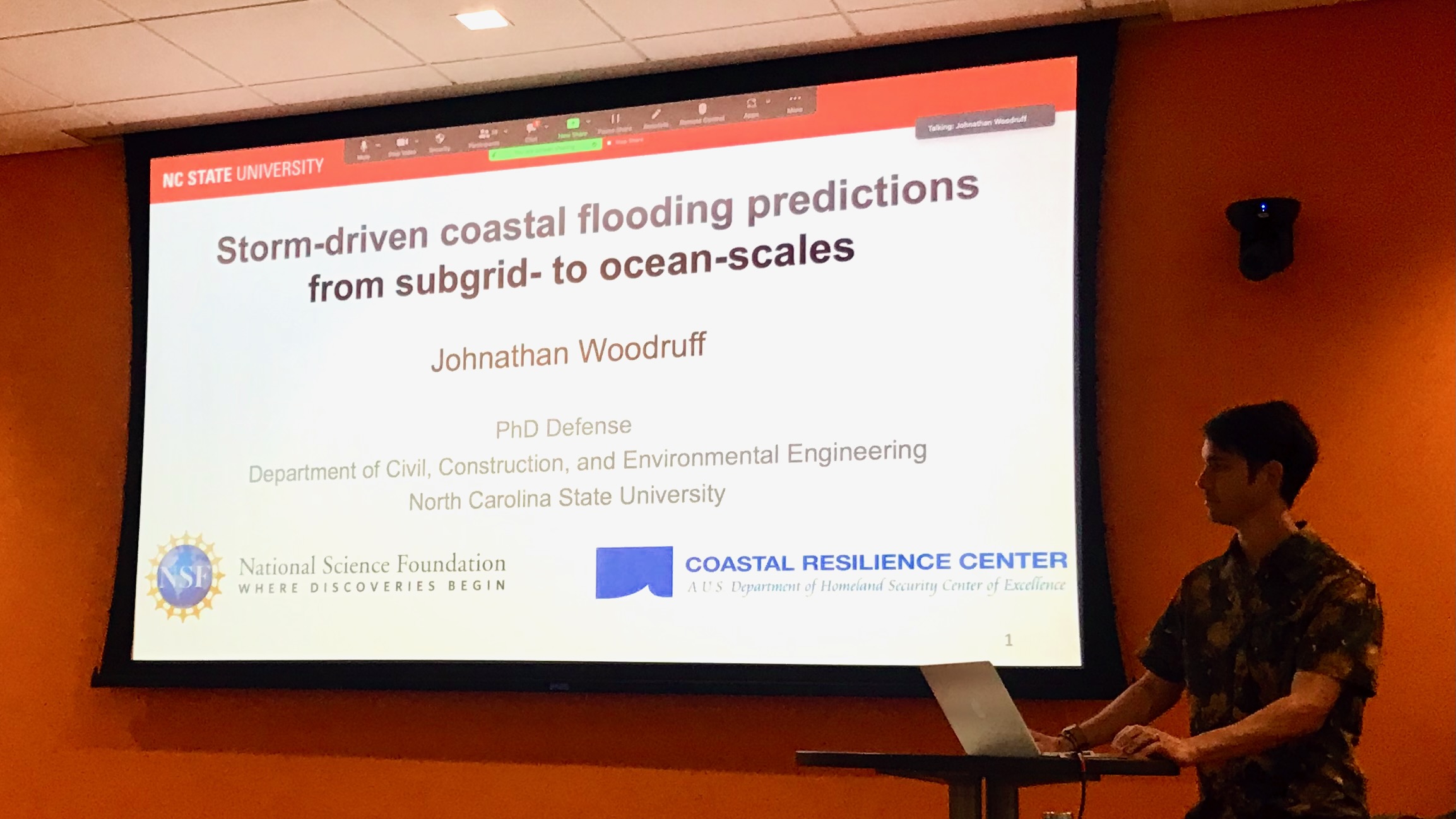
Johnathan starts his dissertation defense.


Johnathan starts his dissertation defense.
 The inland propagation of storm surge caused by tropical cyclones depends on large and small waterways to connect the open ocean to inland bays, estuaries, and floodplains. Numerical models for storm surge require these waterways and their surrounding topography to be resolved sufficiently, which can require millions of computational cells for flooding simulations on a large (ocean scale) computational domain, leading to higher demands for computational resources and longer wall-clock times for simulations. Alternatively, the governing shallow water equations can be modified to introduce subgrid corrections that allow coarser and cheaper simulations with comparable accuracy. In this study, subgrid corrections are extended for the first time to simulations at the ocean scale. Higher-level corrections are included for bottom friction and advection, and look-up tables are optimized for large model domains. Via simulations of tides, storm surge, and coastal flooding due to Hurricane Matthew in 2016, the improvements in water level prediction accuracy due to subgrid corrections are evaluated at 218 observation locations throughout 1500 km of coast along the South Atlantic Bight. The accuracy of the subgrid model with relatively coarse spatial resolution (ERMS = 0.41 m) is better than that of a conventional model with relatively fine spatial resolution (ERMS = 0.67 m). By running on the coarsened subgrid model, we improved the accuracy over efficiency curve for the model, and as a result, the computational expense of the simulation was decreased by a factor of 13.
The inland propagation of storm surge caused by tropical cyclones depends on large and small waterways to connect the open ocean to inland bays, estuaries, and floodplains. Numerical models for storm surge require these waterways and their surrounding topography to be resolved sufficiently, which can require millions of computational cells for flooding simulations on a large (ocean scale) computational domain, leading to higher demands for computational resources and longer wall-clock times for simulations. Alternatively, the governing shallow water equations can be modified to introduce subgrid corrections that allow coarser and cheaper simulations with comparable accuracy. In this study, subgrid corrections are extended for the first time to simulations at the ocean scale. Higher-level corrections are included for bottom friction and advection, and look-up tables are optimized for large model domains. Via simulations of tides, storm surge, and coastal flooding due to Hurricane Matthew in 2016, the improvements in water level prediction accuracy due to subgrid corrections are evaluated at 218 observation locations throughout 1500 km of coast along the South Atlantic Bight. The accuracy of the subgrid model with relatively coarse spatial resolution (ERMS = 0.41 m) is better than that of a conventional model with relatively fine spatial resolution (ERMS = 0.67 m). By running on the coarsened subgrid model, we improved the accuracy over efficiency curve for the model, and as a result, the computational expense of the simulation was decreased by a factor of 13.
JS Knowles, JC Dietrich. “Storm Surge Predictions at Hyperlocal Sites“. Environmental, Water Resources, and Coastal Engineering Research Symposium, North Carolina State University, 10 March 2023.

Storm Surge Predictions at Hyperlocal Sites
TA Cuevas López, BJ Tucker, JC Dietrich. “Toward Prediction of High-resolution Maps of Hurricane-driven Coastal Flooding using Deep Learning“. Environmental, Water Resources, and Coastal Engineering Research Symposium, North Carolina State University, 10 March 2023.
![]()
University of Delaware civil engineers are leading a multi-institutional effort to identify the best models to calculate flood risk at coastal military installations where climate change threatens to increase the risk of flood damage from sea level rise and storm surge.
The four-year project, which launched in mid-2022 and will run through spring 2025, is funded by a $2.2 million grant from the U.S. Department of Defense (DoD). Project partners include faculty and students from the Netherlands, North Carolina State University, the University of South Alabama, Texas A&M and the United States Geological Survey (USGS).
…
“The goal is to provide guidance to the DoD about the strengths and weaknesses of each model in comparison. They’re all going to have things they’re good with and things they struggle with,” Dietrich said. Those comparisons will help the agencies decide what types of models they want to use to get what types of information — depending on how much time, effort and funding they want to commit.
There’s also a goal of reducing cost and building smarter models, he said.
“If we are able to improve our predictions at very specific sites along the coast, we also can have better predictions at other specific sites along the coast, like someone’s house or a bridge or other infrastructure,” Dietrich said.